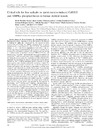Identificador persistente para citar o vincular este elemento:
https://accedacris.ulpgc.es/jspui/handle/10553/44477
| Título: | Critical role for free radicals on sprint exercise-induced CaMKII and AMPKα phosphorylation in human skeletal muscle | Autores/as: | Morales-Alamo, David Ponce-González, Jesús Gustavo Guadalupe Grau, Amelia Rodríguez-García, Lorena Santana, Alfredo Cusso, Roser Guerrero, Mario Dorado, Cecilia Guerra, Borja Calbet, José A.L. |
Clasificación UNESCO: | 241106 Fisiología del ejercicio | Palabras clave: | Antioxidants AMP-Activated Protein Kinase Exercise Fatigue Sprint |
Fecha de publicación: | 2013 | Editor/a: | 8750-7587 | Proyectos: | Integracion de Los Grupos de la Obesidad y El Síndrome Metabólico .... | Publicación seriada: | Journal of Applied Physiology | Resumen: | The extremely high energy demand elicited by sprint exercise is satisfied by an increase in O2 consumption combined with a high glycolytic rate, leading to a marked lactate accumulation, increased AMP-to-ATP ratio, and reduced NAD+/NADH.H+ and muscle pH, which are accompanied by marked Thr172 AMP-activated protein kinase (AMPK)-α phosphorylation during the recovery period by a mechanism not fully understood. To determine the role played by reactive nitrogen and oxygen species (RNOS) on Thr172-AMPKα phosphorylation in response to cycling sprint exercise, nine voluntary participants performed a single 30-s sprint (Wingate test) on two occasions: one 2 h after the ingestion of placebo and another after the intake of antioxidants (α-lipoic acid, vitamin C, and vitamin E) in a double-blind design. Vastus lateralis muscle biopsies were obtained before, immediately postsprint, and 30 and 120 min postsprint. Performance and muscle metabolism were similar during both sprints. The NAD+-to-NADH.H+ ratio was similarly reduced (84%) and the AMP-to-ATP ratio was similarly increased (×21-fold) immediately after the sprints. Thr286 Ca2+/calmodulin- dependent protein kinase II (CaMKII) and Thr172-AMPKα phosphorylations were increased after the control sprint (with placebo) but not when the sprints were preceded by the ingestion of antioxidants. Ser485-AMPKα1/Ser491-AMPKα2 phosphorylation, a known inhibitory mechanism of Thr172-AMPKα phosphorylation, was increased only with antioxidant ingestion. In conclusion, RNOS play a crucial role in AMPK-mediated signaling after sprint exercise in human skeletal muscle. Antioxidant ingestion 2 h before sprint exercise abrogates the Thr172-AMPKα phosphorylation response observed after the ingestion of placebo by reducing CaMKII and increasing Ser485-AMPKα1/Ser491-AMPKα2 phosphorylation. Sprint performance, muscle metabolism, and AMP-to-ATP and NAD+-to- NADH.H+ ratios are not affected by the acute ingestion of. Morales-Alamo D, Ponce-Gonzalez JG, Guadalupe-Grau A, Rodriguez-Garcia L, Santana A, Cusso R, Guerrero M, Dorado C, Guerra B, Calbet JA. Critical role for free radicals on sprint exercise-induced CaMKII and AMPK alpha phosphorylation in human skeletal muscle. J Appl Physiol 114: 566-577, 2013. First published January 3, 2013; doi:10.1152/japplphysiol.01246.2012.-The extremely high energy demand elicited by sprint exercise is satisfied by an increase in O-2 consumption combined with a high glycolytic rate, leading to a marked lactate accumulation, increased AMP-to-ATP ratio, and reduced NAD(+)/NADH.H+ and muscle pH, which are accompanied by marked Thr(172) AMP-activated protein kinase (AMPK)-alpha phosphorylation during the recovery period by a mechanism not fully understood. To determine the role played by reactive nitrogen and oxygen species (RNOS) on Thr(172)-AMPK alpha phosphorylation in response to cycling sprint exercise, nine voluntary participants performed a single 30-s sprint (Wingate test) on two occasions: one 2 h after the ingestion of placebo and another after the intake of antioxidants (alpha-lipoic acid, vitamin C, and vitamin E) in a double-blind design. Vastus lateralis muscle biopsies were obtained before, immediately postsprint, and 30 and 120 min postsprint. Performance and muscle metabolism were similar during both sprints. The NAD(+)-to-NADH.H+ ratio was similarly reduced (84%) and the AMP-to-ATP ratio was similarly increased (x21-fold) immediately after the sprints. Thr(286) Ca2+/cal-modulin-dependent protein kinase II (CaMKII) and Thr(172)-AMPK alpha phosphorylations were increased after the control sprint (with placebo) but not when the sprints were preceded by the ingestion of antioxidants. Ser(485)-AMPK alpha(1)/Ser(491)-AMPK alpha(2) phosphorylation, a known inhibitory mechanism of Thr(172)-AMPK alpha phosphorylation, was increased only with antioxidant ingestion. In conclusion, RNOS play a crucial role in AMPK-mediated signaling after sprint exercise in human skeletal muscle. Antioxidant ingestion 2 h before sprint exercise abrogates the Thr(172)-AMPK alpha phosphorylation response observed after the ingestion of placebo by reducing CaMKII and increasing Ser(485)-AMPK alpha(1)/Ser(491)-AMPK alpha(2) phosphorylation. Sprint performance, muscle metabolism, and AMP-to-ATP and NAD(+)-to-NADH.H+ ratios are not affected by the acute ingestion of antioxidants. |
URI: | https://accedacris.ulpgc.es/handle/10553/44477 | ISSN: | 8750-7587 | DOI: | 10.1152/japplphysiol.01246.2012 | Fuente: | Journal Of Applied Physiology[ISSN 8750-7587],v. 114 (5), p. 566-577 |
| Colección: | Artículos |
Citas SCOPUSTM
51
actualizado el 08-jun-2025
Citas de WEB OF SCIENCETM
Citations
51
actualizado el 18-ene-2026
Visitas
228
actualizado el 15-ene-2026
Descargas
404
actualizado el 15-ene-2026
Google ScholarTM
Verifica
Altmetric
Comparte
Exporta metadatos
Los elementos en ULPGC accedaCRIS están protegidos por derechos de autor con todos los derechos reservados, a menos que se indique lo contrario.
